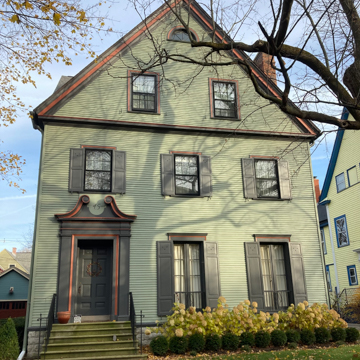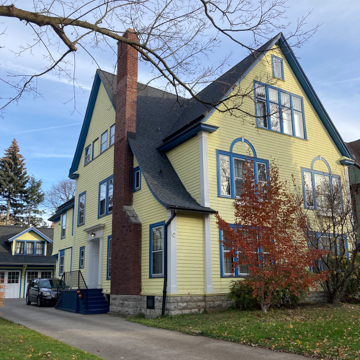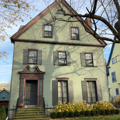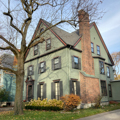Houses at 41 and 45 Lexington Avenue
Louise Bethune, the first professional female architect in America, referred to residential commissions as “the most pottering and worst paid work an architect ever does.” Reluctant to be restricted purely to the realm of domestic architecture, she instead actively pursued other types of commissions that were typically given to male architects. Her extensive career attests to this, as she designed factories, schools, liveries, and hotels in Buffalo and Western New York. She did, however, also design several residences, particularly in the early stages of her career. Ironically, despite her distaste for being pigeonholed into residential design, much of her surviving work are houses in the city of Buffalo.
The Comstock Residence at 45 Lexington Avenue and the Warren Residence at 41 Lexington Avenue are two examples of Bethune’s residential designs that remain intact today. By the time these houses were both constructed in 1890, Bethune had recently become the first woman admitted to the AIA (1888) and the first woman member of the FAIA (1889). She was also a partner in the architecture firm of Bethune and Bethune with her husband (since 1881). She had already befriended and impressed many of Buffalo’s elite citizens, who had grown rich from the railroad, shipping, and steel industries. Several of these citizens were moving away from the central city to quieter streets like Lexington Avenue, which had previously been known as Butler Street until 1888 and had been a fruit orchard during the mid-nineteenth century.
The Comstock and Warren Residences were designed to reflect and accommodate the wealth and prestige of their original owners. The Warren Residence was built a few months earlier, for Melvin F. Warren, a banker and real estate broker with a large investment firm. The Comstock Residence was constructed for George W. Comstock, a successful hatter and furrier who had come from a family of lawyers. Comstock purchased the adjacent lot from Warren in 1889 and the building was completed by late 1890. The Comstock family only lived in the house for six short years before it was sold to a local reverend. The Warren family remained at 41 Lexington Avenue for several decades. Both houses were also large enough to accommodate servants’ quarters on the third floor, as many upper-class houses did during the late nineteenth century. The butler at the Comstock Residence, William Shortwell, was even referred to as an “elite” person of color in one newspaper article that announced his engagement.
Both of these houses were designed in the Colonial Revival style, popular amongst many upper-class citizens in Buffalo, and nationwide, at the time. The style’s name refers to interest in the early Georgian and Adam style houses built during the Colonial era along the Atlantic seaboard. The Centennial Exhibition of 1876 and the Chicago World’s Fair in 1893 sparked a renewed interest in colonial architecture and the colonial period in general. The massing, rhythm, fenestration, and materials of these houses are typical of the Colonial Revival. Bethune’s nuanced handling of the style can be seen in the pilasters and entablatures framing both entrances with different details, where she took a dignified approach to ornamentation.
Today these houses remain single-family residences. Both are designated as contributing to the Elmwood Historic District (East), listed on the National Register of Historic Places.
References
Allaback, S. The First American Women Architects. Urbana: University of Illinois Press, 2008.
“Architects’ Work.” Illustrated Buffalo Express (Buffalo, NY), May 4, 1890: 11.
Barbasch, Adriana. “Louise Blanchard Bethune: The AIA Accepts Its First Woman Member.” In Architecture: A Place for Women, edited by Ellen Perry Berkeley, 15–25. Washington, D.C.: Smithsonian Institution Press, 1989.
Bethune, Louise. “Women and Architecture.” Inland Architect and News Record 17 (March 1891): 20–21.
“Bethune, Louise.” Who’s Who in New York City and State 4 (1909): 117.
Dinerman, Barbara. “Women in Architecture.” Architectural Forum 13 (December 1969): 50–51.
Hays, Johanna. Louise Blanchard Bethune: America’s First Female Professional Architect. Jefferson, NC: McFarland & Company, Inc., 2014.
“Lexington Avenue Residence Sold.” Buffalo Times (Buffalo, NY), March 25, 1917: 47.
“Lots.” Illustrated Buffalo Express (Buffalo, NY), July 24, 1889: 8.
“Two of the Colored Elite Were Married By His Honor This Morning.” Buffalo Enquirer (Buffalo, NY), January 20, 1892: 6.
Writing Credits
If SAH Archipedia has been useful to you, please consider supporting it.
SAH Archipedia tells the story of the United States through its buildings, landscapes, and cities. This freely available resource empowers the public with authoritative knowledge that deepens their understanding and appreciation of the built environment. But the Society of Architectural Historians, which created SAH Archipedia with University of Virginia Press, needs your support to maintain the high-caliber research, writing, photography, cartography, editing, design, and programming that make SAH Archipedia a trusted online resource available to all who value the history of place, heritage tourism, and learning.



















